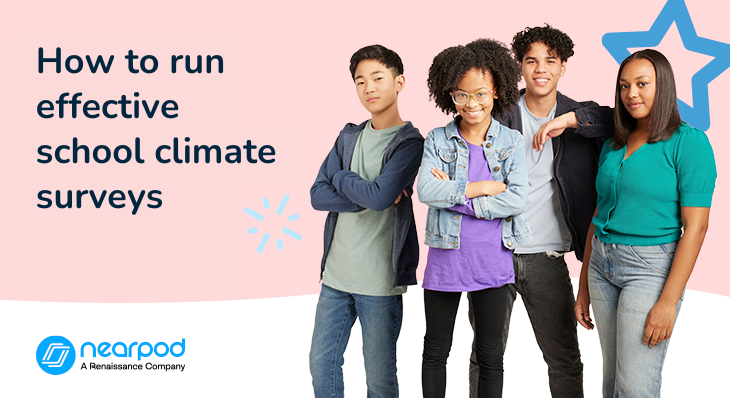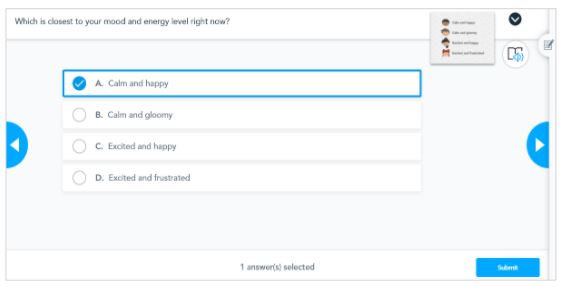
8 Steps to implement school climate surveys effectively
Each new calendar year marks the start of the second half of a school year, which is the perfect time to ask for feedback from your stakeholders about how they feel about their school experience, often called “school climate.” At this point, everyone has (hopefully) settled in enough to have concrete opinions about what they appreciate about the year thus far or what they might like to see improved, all with the goal of finishing the school year strong. However, school climate can be assessed at any point during the school year if needed, as long as students have been in school for at least two months. While school climate surveys aren’t usually sent out until the end of the school year, it’s best to begin early when designing and planning for such an annual feedback cycle to gain insight on how to improve school climate.
What is school climate?
School climate refers to how the school’s stakeholders are feeling about the school. It represents the current temperature—quite literally, whether the staff, students, and families are feeling hot or cold about their personal experience. School climate surveys can take into consideration the campus and facilities, the curriculum and services, as well as the leadership, staff, and overall community of students and their families. There is always a myriad of factors and variables that can affect school climate—the school’s atmosphere or mood—each and every year, so it is important to get a regular pulse on such feedback to better understand the patterns or deviations.
What is the difference between school climate and culture?
Sometimes, we hear “school climate” and “school culture” being used interchangeably, or they are lumped together in one utterance. However, culture vs. climate in schools is quite different. School climate is the current temperature of a school, as rated by its primary stakeholders. The school climate can fluctuate yearly due to internal and external factors. The goal is to maintain a positive school climate.
School culture, on the other hand, is more aspirational. A school’s mission statement or philosophy usually sets the tone, and as the school administrator, you can create short- and long-term goals that ladder up to what you want your school’s culture to be. Sometimes, school culture is referred to as the personality of the school—what beliefs, values, and practices the community tries to uphold. And again, a school is inclusive of the campus, the curriculum, the certified and classified staff, the student body, and the families. It includes the tangibles like structures, resources, and services, as well as the intangibles like spirit, attitude, and behavior. The goal is to outline and develop a positive school culture for student achievement, school safety, and staff and families. A positive safe supportive atmosphere contributes to improved academic achievement, as students who feel valued and secure are more likely to thrive academically.
How to create a school climate survey
Each spring for elementary, middle, and high school, consider how to design a comprehensive survey that takes into account various stakeholders’ perspectives and opinions, including school personnel, parents, and students. As part of the design, you will want to plan on when and how to disseminate the survey and how best to crunch the data. You’ll want to land on a design that you can use year over year, to best compare apples to apples—otherwise, it can be difficult to ascertain true progress. Consider creating a task committee once you have the data so that you can begin to make data-informed decisions and create a plan of action that will increase buy-in.
How Nearpod can help improve school climate
Once you have administered the school climate survey by following the steps below and analyzing the data, Nearpod can help you take the next steps. First, use Nearpod to communicate the results with your stakeholders via a shared presentation. You may want to embed a video thanking participants for their feedback. You can add rich multimedia graphs and visuals to highlight areas where your school is doing well and those that need improvement. You can share your presentation via a code or QR code so that everyone can visit and revisit the information. Second, you may want to ask a few follow-up questions to gain even more clarity. Use a Poll to get a quick pulse on a new idea or to take a vote. You could also use Open-Ended Questions and Draw It to amass more qualitative responses.
You can also be responsive to teachers’ school climate needs by using Nearpod for interactive professional development to host in-person workshops or offer asynchronous learning or enrichment experiences. Similarly, you can address students’ identified needs by suggesting interactive Nearpod lessons or modifying existing activities. With spring marking the onset of state testing, you can create original content for test prep needs to fill learning gaps or address concerns shared in the school climate survey feedback.
New to Nearpod?Administrators can schedule a call to learn about the full instructional power of Nearpod for your schools and districts. Teachers can sign up for free below to access and create interactive lessons.
8 Steps to implement school climate surveys effectively
1. Determine your demographic data set
In order to slice and dice survey results, you will want to ask a concrete set of demographic questions of your survey takers each year. You will want survey takers to choose their primary role: administration, certified staff, classified staff, student (you could bifurcate by grade), and parent/guardian. With such a designation, you can filter the data results by role to determine how a survey taker’s role affects their input. A class climate survey can help gain insights into the overall school environment. By gathering feedback from students through a student survey, one can better understand how the classroom and school setting impact learning.
You may want to ask how long they have held such a role and how long they have been at your campus. Often, newcomers have a steeper learning curve, which can affect their opinions and perspectives. Likewise, a long-time participant can have more fidelity or, conversely, be more complacent.
Asking demographic questions upfront will help you design the survey with logical rules, meaning you can serve specific questions based on their identifying factors. For instance, you may want to know a bit about a new staff member’s prior recent teaching experience, which may help contextualize their feedback. Look at examples of other surveys online that are valid and reliable—they don’t have to be school-specific—to see what types of analogous demographic questions are required.
2. Add a personal note as a survey description
At the top of most surveys, you can add a description. Use this space to add a personalized note from you, the school leader, thanking your partakers for spending the time on the survey. Reiterate that you are looking for honest and candid feedback so that the school can take constructive steps to improve itself. Underscore that your school is built to serve and support all, so every opinion is valid and valued.
You may even want to word it as a letter to better position the survey takers’ mindset before they begin. Make sure to give an estimate of time required to take the survey, so that they are prepared beforehand to finish the survey—incomplete survey results should not be counted. Be profuse in your gratitude and share how you plan to digest the feedback into an actionable climate improvement plan.
3. Make it optional to share personal identifying information
While you should make most of the school climate survey questions “required” in order to move on to the next question and complete the survey, make the sharing of a name, personal email, and phone number optional. Most will opt into sharing, and knowing where feedback came from can help you follow up and dig for more details. You also can address the most problematic feedback head-on if you know from whom it came. Don’t require names and emails, as it can color the feedback early on and make survey takers hesitant to be candid. You may be surprised at how many willingly share their contact information.
4. Ask for quantitative feedback followed up by qualitative
You will want a mix of question types in your school climate survey. Quantifiable questions are closed and have definitive answers—yes/no, true/false, rank: 1, 2, 3, 4, 5. In most cases, you can tally the results and get quantifiable data in terms of percentages or numbers. Qualitative questions are open-ended, so their responses must be read and deciphered individually.
A good rule of thumb is to ask a quantifiable question and give definitive answer choices. Then, use a logic rule to follow up on the good and the bad. For instance, if someone ranks a service the best at a 5, follow up by asking, “Why were you so pleased with this service?” If someone ranks a service the worst at a 1, follow up by asking, “Why did you feel that we failed you with this service?” Often, a ranking has clear causation, and you can pinpoint reasons for such good/bad feedback. Extreme respondents, those with opinions on opposite sides of a spectrum, often offer the most actionable feedback, and by addressing their needs, you can meet the needs of all those who fall in between.
5. Make an action plan
Before you send out a school climate survey, you need to determine an action plan for what will happen after you get the school climate assessment results. Often, those who administer the survey end up drowning in survey data. They ask the questions, gather the data, and then sit on it. Don’t fall into the trap of data paralysis. Proactively form a task committee to review and try to make sense of the data. Form a cross-functional committee of volunteers, with all stakeholders represented. Their deliverable can be to create a list of recommendations to address the school climate feedback. Make sure to share their recommendations far and wide so that survey takers will know that their input has been heard and that the school is committed to improvements year over year.
6. Set a firm deadline
Now, with a survey designed and an action plan set, begin your communication plan about the annual school climate survey. Be very clear in your communications about when the survey will close. You can share such information in typical ways, such as newsletters and emails. You may also want to be innovative and post QR codes around the school hallways.
Just as you would share a Nearpod lesson, you can share a Nearpod survey. Consider sharing the URL, the participation code, or the QR code. Send it in an email as a newsletter, or share it on the school website.
Set an internal goal of how many stakeholders you would like to have participate (X% of the staff, X% of the student body, X% of families) and tailor the messaging accordingly. You may even want to post and share about the level of participation. If needed, you can always extend the deadline at the last minute. Still, ideally, your communications should be straightforward and convincing enough that everyone will take the time to participate and engage.
7. Look for trends and patterns
Once the data has been gathered, look for patterns and outliers. The trends, patterns, and one-off perspectives may be new or tried and true, for better or worse. As you crunch the data, use visuals such as bar or pie charts to help you internalize the good, the bad, and the ugly. Don’t shy away from asking the hard questions or facing the candid facts. As you probably have heard from your mother’s advice, frame the feedback in a way that shares the most critical and constructive first, then ends with a high of all the positive and glowing comments. Definitely highlight examples of positive school climate as identified by your survey takers.
8. Act
Plain and simple: Make sure to act on the feedback. Once the data has been summarized, it is your job as a leader to incorporate it into an overall school improvement plan. Awareness needs to be followed by a commitment to action. And it helps to compartmentalize the steps—for example:
- What can you do before school ends?
- What can you do before the next school year starts?
- What can you do in a year’s time?
Clearly communicate the reason behind any extended timeline (budget, training, board approvals, etc.) so that a delay doesn’t become misconstrued. But be clear in your communication of what you plan to address, how, and when. The worst sign of lack of progress is repeated poor survey remarks on the same issue year after year.
Explore the best practices for how to provide teachers with effective feedback in this blog post!
Improve school climate with Nearpod’s support
School climate is critical to a school’s success, whether you’re looking through a leadership lens or that of a student. A positive school climate can lead to increased student attendance and engagement, increased teacher retention, and improved community involvement. Your goal is to make sure everyone has a voice to provide feedback at the end of the year and that they feel they have been heard. Your first year or two using climate surveys for schools may feel like a trial, but the feedback (or holes in the feedback) will help you strengthen your survey design for the coming year, and if needed, you can always send out a short-format follow-up survey. Such dedicated annual efforts will help your whole school community learn how to create a positive school climate and teaching and learning environments. Good luck!
New to Nearpod?Administrators can schedule a call to learn about the full instructional power of Nearpod for your schools and districts. Teachers can sign up for free below to access and create interactive lessons.

Darri Stephens is a dedicated LX (learning experience) designer, passionate about creating quality content and programs for kids, families, and educators. With MAs in Education from both Harvard and Stanford, and work experience at best-in-class ed tech organizations including Wonder Workshop, Nickelodeon, and Common Sense Education, she is steeped in the design thinking process and committed to agile and iterative project management, which has resulted in multi-award-winning programs and products.






